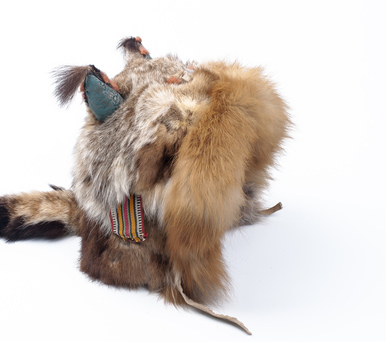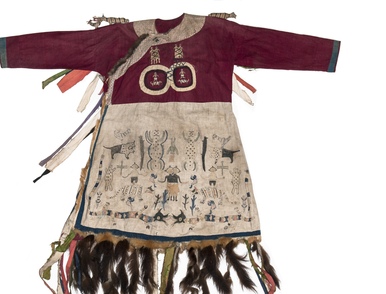Women’s clothing, like men’s, included the following elements: shoulder upper and lower — robes, waist — pants and leggings, as well as additional accessories, headdresses and various ornaments. The additional accessories, besides belts, gloves and armlets, included skirts, aprons and bibs.
The Ulchi people sewed Amur and Tungusic (Evenki) types of bibs. They were fastened around the neck, and sometimes went down to the knees (women’s items) and were worn under clothes. Bibs were part of women’s costume from an early age.
Girls from the age of four or five had a small dilba bib sewn onto their pants. The bibs worn by young and older girls were hexagonal, covering the chest almost up to the neck. Women wore everyday long quadrangular aprons of the Evenki type lelue/leli, which reached to the knees.
There were also short wedding bibs made of silk and deerskin, they were decorated with embroidery using deer hair from under the neck and appliqué. In the upper part they were embroidered with beads and small metal plaques, in the lower part they were adorned with large shaped metal pendants.
This exhibit was sewn from Chinese silk scraps on the front side using a T-shaped insert made of deerskin. The item was decorated with embroidered white deer hair from under the neck, “dense herringbone” stitch, and rectilinear geometric pattern, which was executed with multicolored threads.
On both sides of the deerskin insert a vegetal pattern was embroidered on strips of brown silk fabric with threads of the elk’s aorta. A strip of cotton fabric was attached to the insert at the bottom. As a rule, a wedding bib’s function was not so much practical as a protective one of an amulet.
The Nanai people had similar elements of clothing. Daily bibs were worn until old age. Women were buried wearing a daily or wedding bib of the Evenki type, and if they did not have one, a burial bib of the Amur type was made.
In the past, men also
wore pentagonal or hexagonal bibs of the Amur type. They were short and made of
cloth (30 centimeters at most), practically not ornamented. Both types of bibs
— Amur and Evenki — coexisted for a long time among all indigenous peoples.
Only by the end of the 19th century Amur bibs almost disappeared and were
preserved as an item that was part of the vestments of the dead. During the
same period, Evenki-type bibs were also going out of use.

